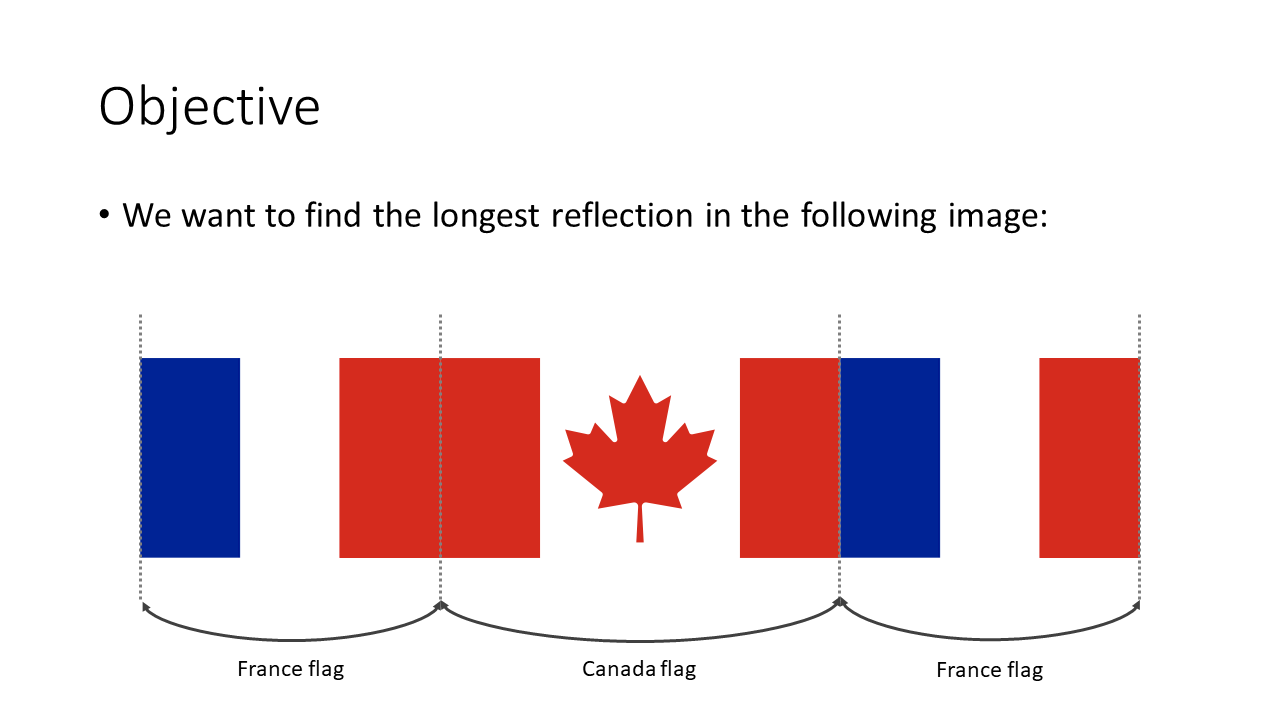[LeetCode] 用對稱圖形來理解 Manacher's Algorithm #5 Longest Palindromic Substring
Manacher's Algorithm 被大家形容得好像是很困難的演算法。於是我在想,有沒有辦法把 Manacher's Algorithm 用好玩的方式來理解呢?
更簡單的演算法可以參考上一篇文章。
理解 Manacher's Algorithm
對稱半徑
回文相對於圖片就是對稱圖形的概念,我們今天的目標就是找法國、加拿大、法國國旗組在一起裡面最寬的對稱圖形:
如果我們這樣切,每個地方都可以當摺線,我們可以說對稱的地方半徑是 2:
因為往左或往右都有 2 塊。
沒有對稱的地方就是 0:
當然還有另外一種對稱是不看中間的那塊,像是文字 "aba" 我們就可以不看 "b",像是我們可以忽略楓葉中間那塊:
對稱中的對稱 (Case 1)
這大概就是 Manacher's Algorithm 裡面最核心的概念。
假設我們已經知道有一塊半徑是 6 的對稱,如果左邊有一小塊半徑 1 的對稱,那我們可以知道右邊的對稱半徑嗎?
如果你把左半邊連數字和箭頭也當圖片的話,那右半邊不就長的一樣? 那半徑也就一樣?
沒錯,這種感覺就好像蝴蝶翅膀上面比較小的圈圈自然也會對稱在另外一邊:
被砍掉的對稱 (Case 2)
那如果有對稱超過藍色對稱的範圍怎麼辦? 像是這樣:
既然藍色對稱的範圍只到那邊,就代表他的外面一定不一樣,我們當然不能 copy 左半邊的半徑:
真可惜,不過我們會發現,我們還是可以把右半邊往中間擠到藍色對稱範圍裏面就可以對稱了:
可以更寬的對稱 (Case 3)
我們再來看最後一個 case,如果左半邊剛好碰到邊緣會發生什麼事? 這邊我把加拿大國旗中間一小塊換成藍色的:
的確這和 Case 1 看起來好像沒什麼差別,一樣的對稱半徑,But...
我們如果把右半邊的對稱稍微拉長一下,會發現,哇,右半邊有可能變更長耶,左半邊卻是沒辦法:
Manacher's Algorithm 設計是當碰到這個情形就把藍色的中心點移到這個新的地方繼續跑,因為我們還沒讀到右邊邊界外,沒人知道他會變多長,這只能繼續乖乖左右慢慢拉開嘗試。
所以 Manacher's Algorithm 比 O(n^2) 演算法聰明的地方就只有重複利用上面藍色對稱的部分裡面的資訊,只要超出這個範圍,很抱歉就只好一個一個字元比較。
實作技巧
大部分網路上的解答都是和 Wikipedia 一樣先替 s 加上一堆 "#" 或是 "|",但是為何一定要加? 我就不想加,於是我在 index 上面動手腳:
我可以設計一個 function 專門回傳 s 第幾個字元是什麼,把虛線灰色框的地方的 index 都回傳一個不存在的字元 (像是 "|") 。
這樣有什麼好處? 除了比較省記憶體也是讓設計者比較偏用 index 來設計演算法,甚至在檢查左右字元是不是一樣你只要看 index 是偶數其實就可以跳過不用真的去抓字元,少了一次存取和比較。
演算法
Step 1 我們都是學 O(n^2) 演算法一樣左右找最長的對稱,找到後就把右半邊根據上面說的 Case 1, 2, 3 來 reuse 左半邊的資訊,直到 Case 3 發生:
Case 3 發生怎麼辦? 那就從這個地方繼續跑 Step 1,但可以跳過一些距離不用判斷:
C++ 程式碼
這次的程式碼我就真的是先設計出上面的投影片再來實作的 (之前幾次都是先寫 code 、再來做投影片、再來寫部落格)。對我來說上面的圖像對稱概念已經變成我記憶宮殿中一部分了,一個月後再來問我我還是寫得出來:
#include <cmath>
class Solution {
public:
std::string longestPalindrome(std::string s) {
int skipDistance = 0;
for (int center = 0; center <= maxIndex(s); center++) {
// Check if the radius has been filled
if (m_radii[center] > 0) continue;
findLongestRadius(s, center, skipDistance);
skipDistance = fillRightHandSide(s, center);
}
return findLongestSubstring(s);
}
private:
void findLongestRadius(const std::string &s, const int center,
const int skipDistance = 0) {
m_radii[center] = 1; // Self
m_radii[center] += skipDistance;
int left = center - 1 - skipDistance;
int right = center + 1 + skipDistance;
const int minLeft = 0;
const int maxRight = maxIndex(s);
while (left >= minLeft && right <= maxRight &&
getChar(s, left) == getChar(s, right)) {
m_radii[center]++;
left--;
right++;
}
}
int fillRightHandSide(const std::string &s, const int center) {
int skipDistance = 0;
int left = center - 1;
int right = center + 1;
const int minLeft = leftBound(center, m_radii[center]);
const int maxRight = rightBound(center, m_radii[center]);
while (left >= minLeft && right <= maxRight) {
const int radiusOnLeft = m_radii[left];
const int maxRadiusOnRight = calcRadius(right, maxRight);
if (radiusOnLeft < maxRadiusOnRight) {
// Case 1
m_radii[right] = radiusOnLeft;
} else if (radiusOnLeft > maxRadiusOnRight) {
// Case 2
m_radii[right] = maxRadiusOnRight;
} else {
// Case 3: skip this distance for the next step 1
skipDistance = maxRadiusOnRight - 1;
break;
}
left--;
right++;
}
return skipDistance;
}
std::string findLongestSubstring(const std::string &s) {
// Find center index with the max radius
int maxRadius = 0;
int center = -1;
for (int i = 0; i <= maxIndex(s); i++) {
if (m_radii[i] > maxRadius) {
maxRadius = m_radii[i];
center = i;
}
}
// Produce the palindrome
std::string substr;
for (int i = leftBound(center, maxRadius);
i <= rightBound(center, maxRadius); i++) {
if (i % 2 != 0) substr += getChar(s, i);
}
return substr;
}
char getChar(const std::string &s, const int index) {
if (index < 0 || index > maxIndex(s)) return '\0';
if (index % 2 == 0) return '|';
const int realIndex = index / 2;
return s.at(realIndex);
}
int maxIndex(const std::string &s) { return 2 * s.size(); }
int calcRadius(const int from, const int to) {
return std::abs(to - from) + 1;
}
int leftBound(const int index, const int radius) {
return index - radius + 1;
}
int rightBound(const int index, const int radius) {
return index + radius - 1;
}
private:
int m_radii[2 * 1000 + 1] = {0};
};
上面的實作細節我還有額外的投影片在 GitHub 內,這邊為了簡潔我就不放上來了。
程式碼有點長? 沒錯,主要原因是因為我都沒 reuse 一些 variables,我把 Step 1 & Step 2 完全分開成兩個獨立的 functions 來做,這樣你可以看得很清楚唯一在下一個 while loop 被 reuse 的資訊只有 skipDistance。
我也把 index 和 radius 的計算規範成 maxIndex, calcRadius, leftBound, rightBound 這些 functions,那你在寫主邏輯的地方就不用再去多想是不是忘了 -1 還是 +1。
如果你要寫很短的程式碼當然也行,可是只要一個地方不小心弄錯,要 debug 起來可是很困難。
我就寧願寫看起來笨一點的程式碼,看得懂、好維護比較重要。
Submission 結果
又快又省記憶體,預料中的事。
更短的 Code
就是想要比較短的 code? 沒問題,我當然可以把上面的程式碼經過各種優化+簡化後可以變成底下這樣:
class Solution {
public:
std::string longestPalindrome(std::string s) {
int radii[2 * 1000 + 1] = {0};
int maxRad = 0, maxRadC = 0, maxRadRight = 1;
for (int c = 0; c <= 2 * s.size(); c++) {
if (radii[c] > 0) continue;
radii[c] = maxRadRight;
for (int l = c - radii[c]; nth(s, l) == nth(s, c + (c - l)); l--) {
radii[c]++;
}
const int maxRight = c + radii[c] - 1;
for (int l = c - 1; l >= c - radii[c] + 1; l--) {
maxRadRight = maxRight - (c + (c - l)) + 1;
if (radii[l] == maxRadRight) break;
radii[c + (c - l)] = std::min(radii[l], maxRadRight);
}
if (radii[c] > maxRad) {
maxRad = radii[c];
maxRadC = c;
}
}
return s.substr((maxRadC - maxRad + 1) / 2, (maxRad * 2 - 1) / 2);
}
char nth(const std::string &s, const int index) {
if (index < 0) return '^';
if (index > 2 * s.size()) return '$';
if (index % 2 == 0) return '|';
return s.at(index / 2);
}
};
加上看過其他篇文章的 idea 後,這是從上面比較長的版本慢慢優化變成的,其中還加入了一些技巧:
- 把 right 去掉,因為 center + (center - left) 就等於 right
- 把 case 1 & case 2 合在一起,最後再處理 case 3
- 可以觀察發現藍色對稱部分是最長的,中間的小對稱不可能比他長,所以我們提早檢查 radius 是不是最長的
- 把 skipDistance 和 maxRadiusOnRight 合在一起,反正他們只差 1 而已
- nth 讓前面和後面超出範圍的 index 回傳不一樣的字元,這樣我就不用檢查 left 和 right 的邊界,反正超出邊界一定會 nth(s, l) != nth(s, r)
- 最後用會令人頭暈的 index 計算來直接算出 substring 應該從哪開始還有長度
經過了各種 Compiler Error, Wrong Answer 和各種 debugging 後的結果:
速度根本沒差,記憶體倒是省了 0.1 MB。值得嗎?
過了一分鐘再回頭看我已經看不懂了,不過變短的 code 還是有一個比大部分網路解答好的地方就是省記憶體,因為我沒有真的插入 ^ # $ 那些字元到 s。


















留言
發佈留言